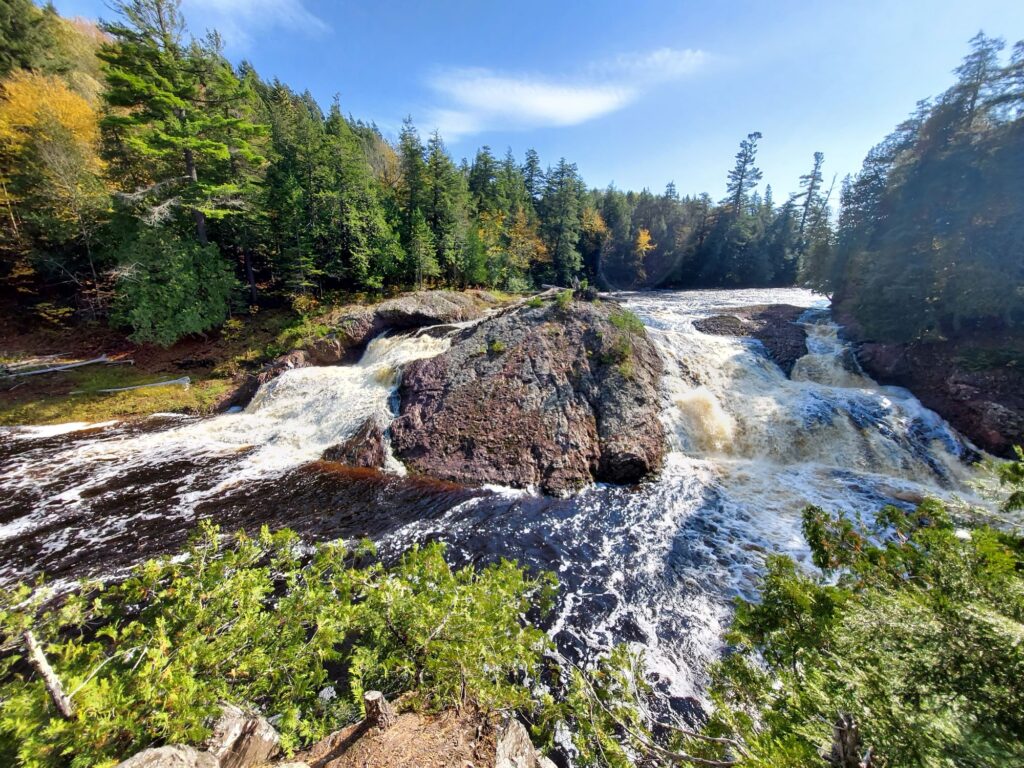St Louis River
Superior Waterway

The call of the wild may be no stronger anywhere in the lower 48 than the headwaters of the St. Louis River. Beginning in the Laurentian Uplands, where small streams divide in three directions toward Hudson Bay, Lake Superior, and the Mississippi River, it’s a land of timber wolves, moose, and Canada lynx. Wood turtles, sturgeon, walleye, northern pike, bass, bluegill, black crappie, channel catfish, and 163 species of breeding birds call the river home, savoring lush wetlands and wild rice lakes that led the Ojibwa people to settle the region.
This 194-mile river, which drains 2.4 million acres of Minnesota’s northern forests and wetlands, remains the primary reservation fishery for the Fond du Lac Band of Lake Superior Chippewa. Below the reservation, it flows through the magnificent Jay Cooke State Park and into a rare freshwater estuary between the twin ports of Duluth, MN, and Superior, WI, where it enters Lake Superior as the largest U.S. tributary of the entire Great Lakes system. The lower St. Louis is the only river in the state with whitewater rafting opportunities.
The Backstory
Historically, the estuary was heavily impacted by industry, resulting in designation as a Great Lakes Area of Concern after the lower river became one of the most heavily polluted waterways in the state by the mid-20th Century. It still hosts the busiest port on the Great Lakes. However, an investment of more than $1 billion and a commitment to restoration and economic development by the City of Duluth has the lower St. Louis well on its way to recovery.
Upstream, the main stem of the St. Louis River and several of its larger tributaries have been dammed for hydropower generation, disrupting connectivity and increasing mercury bioaccumulation in fish. Additionally, the St. Louis River and its tributaries have been adversely impacted by more than a century of iron mining, with the loss of thousands of acres of headwaters wetlands and streams.
Did You know?
Jay Cooke State Park, one of the 10 most visited in Minnesota, celebrated its 100-year anniversary in June 2015.
The rocky gorge of the St. Louis River at Jay Cooke State Park was not navigable to canoes, so Native Americans blazed a 6.5-mile portage around it. Later voyageurs dubbed it the “Grand Portage of the St. Louis.”
Duluth, MN, at the mouth of the St. Louis River at Lake Superior was named for Daniel Greysolon, Sieur du Lhut, the first European to explore the area in 1679.
WHAT STATES DOES THE RIVER CROSS?
Minnesota

The river found its way onto the America’s Most Endangered Rivers® list in 2015 due to the threat of sulfide-ore mining. This type of mining releases copper and nickel bound up in sulfide-bearing rock, and commonly results in acid mine drainage and increased levels of heavy metals and sulfates in downstream waters. Allowing this type of mining in the St. Louis River and Boundary Waters regions of Minnesota will ruin wild places and contaminate water for people, fish and wildlife.

Let's stay in touch!
We’re hard at work in the Midwest for rivers and clean water. Sign up to get the most important news affecting your water and rivers delivered right to your inbox.
Increased sulfate degrades wild rice stands and contributes to already high mercury levels in fish that threatens public health. A 2013 study by the Minnesota Department of Health found that 1 in 10 infants on the North Shore of Lake Superior are born with unsafe levels of mercury in their blood, potentially impairing normal development.
The first of the new mining proposals, PolyMet Mining’s NorthMet Project, would destroy 1,000 acres of wetlands and indirectly impact thousands more wetland acres. It would also require a complex federal land exchange resulting in the turnover of more than 6,000 acres of biologically rich lands from the Superior National Forest and the St. Louis River watershed to mining companies.
The Future
Now comes the bad news. Earlier in 2016, the Minnesota Department of Natural Resources (DNR) decided to allow PolyMet to move its mining project forward to the permitting stage despite the reality that no mine of this type has operated and closed without polluting nearby lakes, rivers and streams.
Minnesota Gov. Mark Dayton recently stated his support for protecting the nearby Boundary Waters from similar sulfide-ore mining, clearly acknowledging the risks inherent in this type of mining. The St. Louis River and its communities, tribes and wildlife deserve the same consideration and protection against sulfide-ore mining. If this project is allowed to proceed, there is no turning back.


